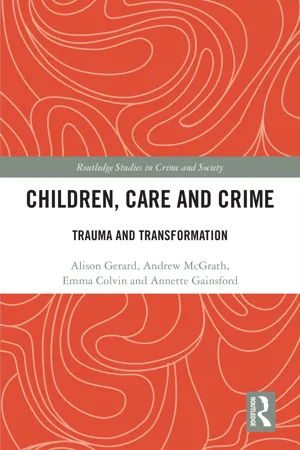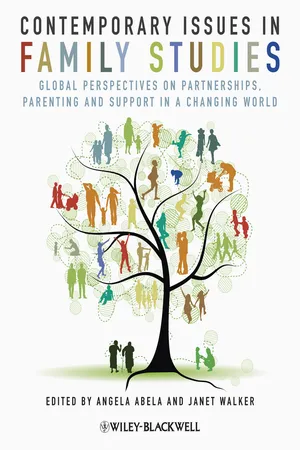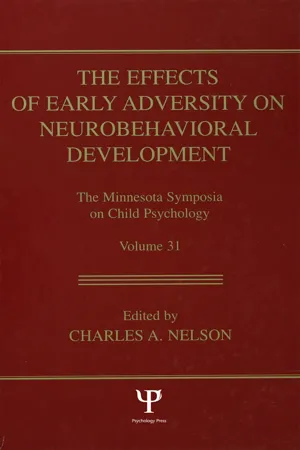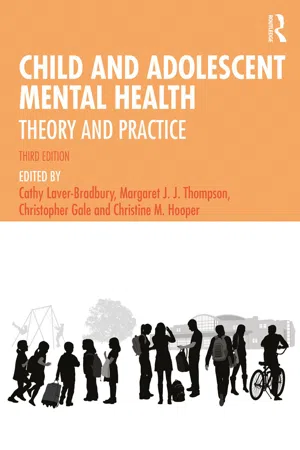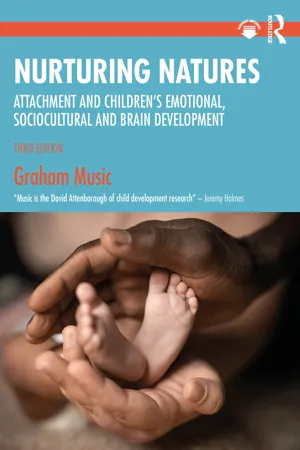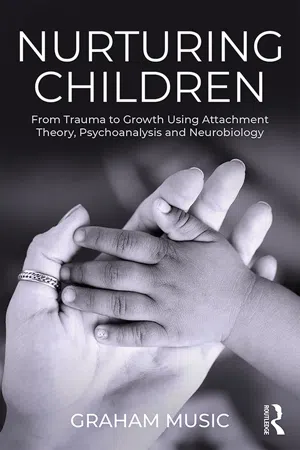Psychology
Romanian Orphan Studies
The Romanian Orphan Studies refer to a series of research projects conducted on children who were raised in institutionalized settings in Romania during the 1980s and 1990s. These studies aimed to investigate the effects of severe deprivation and neglect on child development, particularly in relation to cognitive, emotional, and social functioning. The findings from these studies have contributed significantly to our understanding of the impact of early adversity on psychological development.
Written by Perlego with AI-assistance
Related key terms
11 Key excerpts on "Romanian Orphan Studies"
- eBook - ePub
Children, Care and Crime
Trauma and Transformation
- Alison Gerard, Andrew McGrath, Emma Colvin, Annette Gainsford(Authors)
- 2022(Publication Date)
- Routledge(Publisher)
This is a topic that has been of longstanding interest to researchers. Early research focused on the effect of being raised in an orphanage. Although the methodological strength of these studies varied considerably, three overall conclusions emerged. First, children raised in institutions such as orphanages were vulnerable to a range of harms that could persist across their lives. Second, the degree of physical, cognitive and emotional problems suffered by children raised in orphanages very much depended on the degree of deprivation they experienced. Third, where children were taken out of orphanages at an early age (at less than one year of age), there was evidence of considerable catch-up in the areas in which they had experienced problems (Johnson et al., 2006 ; Woodhouse et al., 2018). The Romanian orphanage study is probably the best-known and most rigorous of these studies. Following the fall of the Ceausescu regime in 1989, a large number of children raised in very poor conditions in Romanian orphanages were adopted in the United Kingdom. They had all entered institutional care at an early age but differed in how long they had spent there. Although there was evidence of recovery for those who had spent less than six months in the orphanages, among those children who had been institutionalised for longer than this, there were considerable long-term maladaptive psychological sequelae impacting behavioural patterns and cognitive functioning (Rutter, 1998 ; Rutter & Sonuga-Barke, 2010). The literature examining the impact of the care experience more broadly, like the orphanage studies, provides considerable evidence of resilience, particularly where children enter care at an early age and experience stable placements (Rutter et al., 1998 ; Tarren-Sweeney & Goemans, 2019) - eBook - ePub
Contemporary Issues in Family Studies
Global Perspectives on Partnerships, Parenting and Support in a Changing World
- Angela Abela, Janet Walker(Authors)
- 2013(Publication Date)
- Wiley-Blackwell(Publisher)
As is shown above, studies of internationally adopted children are not new, having been carried out in those countries which were the major recipients of such children (e.g. the USA, the Netherlands, Sweden, Norway). The originality of the later studies of Romanian children adopted abroad in the 1990s lies in the fact that references to ‘Romanian orphans’ seem to attract the attention of numerous segments of the international research community. There appears to be a common research population of children scattered over the Western world, whose main characteristic is that they were rescued from the ‘terrible’ Romanian orphanages, thus rendering them victims of ‘severe global early privation’ (Rutter and ERA, 1998). Two main theoretical approaches converge as being relevant to studies conducted on Romanian children adopted abroad: the impact of institutional rearing on subsequent child development, and the outcomes of international adoptions.As early as 1992, academic reports were published about the adjustment of Romanian children adopted abroad. Perhaps not surprisingly, these first reports came from medical professionals, since they were among the first to be consulted by adoptive parents confronted with the health problems of their adopted children on arrival or soon after. In this review of some of these studies, a ‘study-centred’ (rather than ‘type-of-outcome-centred’) approach is used, because the heterogeneity in findings often reflects the different research questions, designs and methodologies adopted by particular group(s) of researchers. - Charles A. Nelson(Author)
- 2000(Publication Date)
- Psychology Press(Publisher)
Impairment In Thinking. Postinstitutionalized children learned best by imitation and rote memory but had great difficulty with thinking through a situation and anticipation. This led to problems in any predicament that required logical and sequential thought. Children also had problems in generalizing, in overcoming obstacles, and with excessive concreteness of thought.Since the influx of Romanian adoptees in 1990-91 predated increased placements from the remainder of Eastern Europe, almost all contemporary studies have focused on these children. Ames et al. (1997) have followed two groups of Romanian children adopted to British Columbia during 1990-91 and a Canadian-born control group of children living with their birth parents (Ames, 1997). One study group consisted of 29 Romanian children who were adopted prior to 4 four months of age and had never been institutionalized. The second group included 46 children who had been institutionalized for 8 months or more (median 17.5 months, range 8-53 months), generally spending almost their entire lives within the orphanage. Children were studied twice: the first time when the institutionalized group had spent a median time of 11 months (4-25 months) in their adoptive homes, and again 3 years later when most children were 4.5 years or older. In general, the outcome of the group of Romanian children adopted prior to 4 months of age did not differ significantly from the Canadian-born control group at the second time period. Both of these groups differed significantly from the group of Romanian adoptees who had spent considerable time within institutional care. Their observations are strikingly similar to those of Province and Lipton (1962).Cognitive Outcome
When adopted, every institutionalized child was developmentally delayed and 78% were delayed in all areas tested (fine and gross motor, personal-social, and language). Fewer areas of delay were noted in children who had experience with toys in the orphanage, had been kept clean, had been favorites of their caretakers, or had been in the orphanage a shorter time. Most children made rapid progress during the first years after arrival, with average increases of 2 developmental quotient points per month.- eBook - ePub
The History and Evolution of Psychology
A Philosophical and Biological Perspective
- Brian D. Cox(Author)
- 2019(Publication Date)
- Routledge(Publisher)
Typically, the children, when discovered, were less than half of the normal mental age on many scales. But the good news from these studies is that for those who had spent less than two years in the orphanages, the children bounced back well physically and mentally. By the age of 11, those in the English study were within normal weight limits and were above 90 on average IQ. For most children raised normally, IQ stabilizes by this age, but the Romanian orphans continued to improve intellectually into their teens. This is consistent with what the other studies found, to varying degrees. However, a high proportion of these orphans show what is known as disorganized attachment. Children with disorganized attachment do not seem to have preferred attachment figures. They might be extremely cautious or wary of forming attachments to caregivers or, alternatively, be as over-eagerly friendly to total strangers as to family members or sometimes alternate between the two states. If it persists, such children may be diagnosed as having reactive attachment disorder (RAD), which includes both fear and withdrawal (like Harlow’s monkeys) or overfriendliness in the list of symptoms. These children are sometimes described as desperate for a caring connection, but terrified of being punished if they seek it. More than 40% of the Romanian English adoptees, who have been followed by researchers longest and most rigorously, show these traits into adulthood, as well as a “quasi-autistic” inability to read subtle social cues, along with attention deficits and cognitive deficiencies in complex planning and reasoning. Rutter et al. (2010) call this constellation of traits deprivation-specific psychological patterns, and they are rarely seen in children who have not been severely abused. And some children, even among those raised some time in very poor conditions, do not show these patterns at all and do fairly well over time.Orphanages have not been eradicated everywhere. In Russian “baby homes,” for example, caregivers in 24-hour shifts, with 48 hours off, are expected to feed 16 infants in a single hour, with an average child-to-caregiver ratio of 14 to 1. This is not a plum job, except for those whose second job on their off days claims much of their attention, so turnover in caregiving is so great that a child could have been cared for by as many as 100 different caregivers by the age of 4. Once again, a consortium of American researchers attempted to improve conditions. In a control home, working conditions were kept the same, but the home was spruced up and medical attention improved. In a second home, caregivers—many who had been raised in conservative, punishment-filled provincial Russian poverty—were given 60 hours of paid training, including 19 written modules, in responding sensitively and immediately to children’s bids for affection, but kept to their regular shift schedule. A third home received the same training, but fewer children to care for, “family time” of two hours daily with their charges and a more rational work schedule of seven hours a day for four days and one 12-hour shift a week—no more one day on and two days off. Children always had at least one of their two familiar caregivers present for consecutive days. Those who had been given special sensitivity training did use it, but only those who had sensitivity training and - eBook - ePub
Child and Adolescent Mental Health
Theory and Practice
- Cathy Laver-Bradbury, Margaret J.J. Thompson, Christopher Gale, Christine M. Hooper, Cathy Laver-Bradbury, Margaret J.J. Thompson, Christopher Gale, Christine M. Hooper(Authors)
- 2021(Publication Date)
- CRC Press(Publisher)
The meta-analyses included studies across the maltreatment spectrum, and the vast majority of evidence comes from retrospective reports. Given the poor overlap between retrospective and prospective reports of maltreatment, it is difficult to determine the extent to which these associations are due to bias. We will focus on prospective longitudinal studies focussing on a specific type of maltreatment, i.e. institutional deprivation.Evidence from Prospective Longitudinal Studies of Romanian Orphans
The English and Romanian Adoptees Study (ERA) and the Bucharest Early Intervention Study (BEIP) are the two most prominent longitudinal studies on the impact of neglect in the form of institutional deprivation on development. The studies differ with regard to study design and type of sample. The ERA study (Rutter, 1998) was launched by Professor Sir Michael Rutter in the early 1990s and follows a group of 165 Romanian children adopted from the severely depriving conditions of the Ceausescu orphanages into nurturing UK families and a comparison group of 52 children adopted within the UK as young infants and without a history of early deprivation. The ERA study therefore utilises a natural experiment design (Rutter, Kumsta, Schlotz and Sonuga-Barke, 2012). Children were assessed at ages 4, 6, 11 and 15 years and twice in young adulthood. Brain imaging data was only collected during the last assessment point in young adulthood, though a small subsample had brain imaging data collected at age 16 years.The BEIP is a randomised controlled trial (Zeanah et al., 2003) which began in 2000, a decade after the fall of the Ceausescu regime. Out of a sampling pool of 136 children living in institutions, children were randomised to either one of 57 available foster care placements or care as usual, i.e. remaining in the institutions. In addition, the study assessed a comparison group of 72 never institutionalised children living in Romania with their biological parents.The children were followed up at 42 months, 54 months, 8 years, 12 years (Nelson, Fox and Zeanah, 2014) and most recently at 16 years (Wade et al., 2019). Brain imaging data were collected between the ages of 8 and 11 years and at 16 years (NB not yet published). The two studies differ in some important points: first, the type of research design, natural experiment vs randomised controlled trial, second, their selection of comparison groups, i.e. the development of post-institution reared, adopted children in the ERA study is compared to that of within-UK non-deprived adoptees while the development of post-institution reared, fostered children in the BEIP is compared to (a) children who remained in care as usual, e.g., for most, institutional care, and (b) never institutionalised Romanian children growing up in their biological families and third, the timing of removal from institutional care. The children in the ERA study experienced institutional deprivation typical in pre-revolution Romania, prior to, and during the fall of the Ceausescu regime, whilst the children in the BEIP trial experienced institutional deprivation in post-revolution Romania after the fall of the Ceausescu regime. It is difficult to tell how conditions improved in the orphanages after the fall of the regime and to what extent the deprivation experiences are comparable with regard to severity. - eBook - ePub
Give Sorrow Words
Perspectives on Loss and Trauma
- John H. Harvey(Author)
- 2016(Publication Date)
- Routledge(Publisher)
Thus, with regard to generalizability, it is clear that the ideas and conclusions of the present analysis must be viewed with caution. While daunting, Romania’s different dilemmas probably are less imposing in terms of potential solutions vis a vis different miseries affecting large groups of people throughout the world. For Western psychology, part of the value of studying Romania now is that there is a large number of knowledgeable, English-speaking psychologists in the country who are amenable to collaboration. The same cannot be said for all parts of the world that are undergoing rapid and large-scale social transitions. An exasperating loss issue for Romanian psychology in the late 1990s is the fact that research is becoming extinct because of financial deprivations in the universities and the pressure on researchers to work other jobs in order to survive (Dr. Ilie Vasilescu-Puiu, personal communication).As I hope this chapter attests, Romania has a richness of psychological phenomena for students of loss and coping, as well as scholars working in other areas, that should be of great interest to Western psychologists. They and their psychology colleagues in Romania cannot solve Romania’s many social problems. But they can study them. There is a wealth of information regarding the orphans’ and beggars’ obstacles and potential that awaits psychological investigation. Even more potential for discovery is available to interdisciplinary research teams working on these problems (e.g., psychologists working in concert with political scientists, economists, sociologists, anthropologists, and the like).I believe that Romania represents not only a place where we as scholars of loss and coping can learn a lot about these topics in the 1990s, but also as a place where courage and persistence in the face of adversity are qualities for which we likewise can be greatly enlightened. These qualities come through in various ways to the outsider. Many well-educated Romanians have left the country, or will leave, for better jobs elsewhere. On the other hand, many other well-educated but economically suffering young to middle-aged Romanians remain committed to the country and to addressing its problems. They expect to stay there and raise their families, even if they have to return to living with their parents or relatives in order to make ends meet. They believe in the country and its traditions in spite of all, and they want it to be better for their children. - eBook - ePub
- Bill Prevette(Author)
- 2012(Publication Date)
- Regnum(Publisher)
Because, these children had been neglected in their early years, rarely picked up, held or spoken to, they experienced poor muscle development and physical coordination. ‘Many of these children were subsequently misdiagnosed as disabled and sent to an orphanage for the irrecoverable’ (Morrison, 2004:171). It is believed that the main purpose for sending children to these homes was to hide them away, reinforcing the myth that Romania did not have any social problems or handicapped children. 35 The conditions in the institutions To say that the institutions that served as homes to the thousands of Romanian children were poorly maintained and managed would be gross understatement. The three-tiered system resulted in different standards for the institutions. Some were better maintained than others, but this might be a case of comparing bad to worst. Studies in the early 1990s of the institutions for older children found that staff ratios ranged from 8:1 to 35:1; children received the minimum of personal interaction with adults (Johnson & Groza, 1993). For the children in the worst institutions, no educational or recreational programming was provided. Parents of babies in the institutions were only allowed to visit one hour a week and were not allowed to hold the child; they were only allowed to sit by the bed. 36 As children became older, they had to entertain themselves as best they could and learn to defend themselves against the more aggressive children. Sexual abuse was suspected between staff and children and children with other children. 37 The institutions lacked hot water, soap, washing machines, linens for the beds; children wore and slept in constantly soiled bed and clothes - eBook - ePub
The Nation's Gratitude
World War I and Citizenship Rights in Interwar Romania
- Maria Bucur(Author)
- 2021(Publication Date)
- Routledge(Publisher)
In a strict sense of comparing what available services and policies existed in Romania in 1917 and how services evolved into the 1920s, this is also a story of partial success on the part of private initiative in the form of NGOs. But beyond statistics at the national level there is a more complicated story, for which we have only partial data. Therefore, my conclusions are more speculative in this chapter. The story for the 1920s is also one of exceptional growth in ethnic Romanian women’s public activities in the area of orphan care and education. This development is both implicitly and also directly connected for many women to the work feminist and eugenicist groups were doing in the interwar period regarding women’s rights.Orphans and gender norms
The story of most war orphans is also that of the impoverished widows who constantly looked for ways to survive and put food on the table for their children. The privations those children suffered were a product not only of the war’s horrible military toll. They were also a result of how their mothers before and after the war continued to be considered lesser citizens than men in terms of legal rights (civil, economic, political), as well as actively discriminated against in terms access to stable jobs, equal wages, housing, etc. This is a case study for understanding how, at a time of extreme need and in a context where women’s caretaking skills were becoming professionalized, the state, through its male representatives, chose to address the need by refusing to consider the underlying structural problems. By doing so, the legislators and IOVR administrators limited the effectiveness of their solutions.Figure 5.1 War orphan students swearing allegiance to Apostol Zamfir’s Fire Generation FrontCredit line: © Frontul de Foc, 15 November–15 December, 1934, p. 1Two main issues stand out among those structural problems: to begin with, state funding for orphan related services was chronically low during the entire period and greatly undercut the SOOR institutional network that was ramped up through private initiative, making it impossible for that private network to continue to function long-term (SOOR 1936 - eBook - ePub
- Nelisha Wickremasinghe(Author)
- 0(Publication Date)
- Triarchy Press(Publisher)
This dependency, upon which our survival depends, forces us to pay attention to and learn about others quickly. What we learn is mediated through a complex system of symbols, including language and context, including social norms and expectations. Even though we may de-prioritise them, the belief systems, meanings and associations that we learn in our first years of life stay with us for ever. Over the last 70 years a number of studies have looked at children neglected in early childhood. The majority of these studies focused on children living in care or similar institutions. Bruce Perry’s 13 harrowing research involving Romanian orphans shows how the developing brain may be irreversibly damaged when subject to sensory, physical, emotional and social deprivation. Neglect included lack of food, conversation, touch and play. In some cases it also involved physical and verbal violence and abuse. The children and babies in these infamous orphanages were found confined in, and sometimes tied to, their cots. Some could not speak at all whilst others screamed continuously, often rocking and biting themselves to get some sort of stimulation. Perry and his colleagues discovered striking differences in the head sizes of these orphans against an expected growth norm. In the brain scan below, an image from a healthy 3-year-old is contrasted with one from a severely neglected child of the same age. The brain size is significantly smaller and the dark areas indicate damage or atrophy in certain areas of the brain which support cognitive, social and emotional functions. This is a dramatic image and stark evidence to show how significant our formative experiences are. This kind of research finds corroboration in many other studies including L - eBook - ePub
Nurturing Natures
Attachment and Children's Emotional, Sociocultural and Brain Development
- Graham Music(Author)
- 2024(Publication Date)
- Routledge(Publisher)
Harlow et al., 1965 ).Serious early deprivation also often leads to a stunting of physical growth (Sonuga-Barke et al., 2022 ). On the other hand, when premature infants receive touch, such as via the well-researched intervention of kangaroo care (Cristóbal Cañadas et al., 2022 ), they gain weight, as has also been shown when premature infants receive massage therapy (Lu et al., 2020 ). One more anecdotal early study (Widdowson, 1951 ) examined children in orphanages. Those who were looked after by a kindly, generous matron grew physically much more than children in the other orphanage, even though food intake was kept identical in both. Indeed, when the loving matron was transferred to the other orphanage, the growth of the previously deprived children caught up! Such cases are now technically known as ‘non-organic failure to thrive’, which is very linked to neglect (Burge et al., 2019 ).Generally the more severe the deprivation, the worse the effects. Many adopted from Romanian orphanages showed serious attachment issues, such as indiscriminate sociability, but those with the worst symptoms had generally spent much longer in institutional care as opposed to those who were adopted or fostered (Smyke et al., 2014 ). Those placed in foster care dropped much of their symptomatology such as rocking, developed better social skills and became more able to accept help. A battery of tests showed that in many respects those placed in good foster care did not differ from children who were never institutionalised. This contrasts with the children who remained institutionalised, who were more withdrawn, unresponsive and disinhibited. Indeed, big differences were seen even in immune and metabolic function when these children reached adolescence (Slopen et al., 2019 ). Excitingly, researchers also found hopeful brain changes, such as growth in white matter, in those placed in foster care as well as large gains in IQ (Humphreys et al., 2022 ), signifying that, if caught earlier, many of these effects can be reversed. Similar gains were shown in a large sample of UK children adopted from institutional settings who lost many of their symptoms (Román et al., 2022 - eBook - ePub
Nurturing Children
From Trauma to Growth Using Attachment Theory, Psychoanalysis and Neurobiology
- Graham Music(Author)
- 2018(Publication Date)
- Routledge(Publisher)
Much psychotherapy is concerned with getting people out of the threat system, out of resorting to fight and flight too quickly and helping them back into the soothing affiliative system. Neglected children also struggle to get into the affiliative system but are less in their threat systems, as they have often not been subjected to frightening experiences like violence. Rather they have lacked good growth-enhancing experiences. This means they require a different therapeutic technique, one that stimulates pleasure, healthy excitement, novelty and hope.Thankfully, change is possible. Children from depriving Romanian orphanages placed in good foster placements have been shown to improve dramatically compared to those who remain (Smyke et al. , 2014). They have better executive functioning, with its neural correlates in prefrontal brain areas, increased brain connectivity and exciting new growth of vital white matter (Vanderwert et al. , 2016).In real life, thankfully, we rarely see the pure forms of neglect witnessed in very depriving orphanages. Most neglected children have some good input as well, and many also suffer overt abuse. However, they are nearly always avoidant and overly self-sufficient. Contrary to appearances, in the Strange Situation Test when their mother leaves them, avoidant children have similar physiological responses to secure children, such as sweating and faster heart rates. However, we seldom spot these signs of anxiety. They have learnt to cut-off from bodily distress signals, due to having parents who responded negatively to signs of neediness.We often see something similar in infants of depressed mothers. When mothers are withdrawn and unable to interact much (Field et al.
Index pages curate the most relevant extracts from our library of academic textbooks. They’ve been created using an in-house natural language model (NLM), each adding context and meaning to key research topics.
